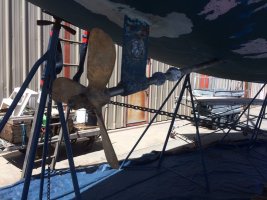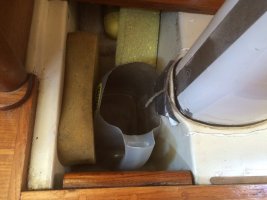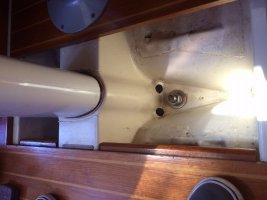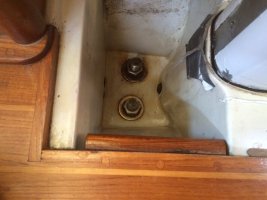Hello everyone,
I am significantly impressed with the amount of activity on this website. One of the reasons why I'm looking at Ericson's is because of the strong following and large knowledge base.
This particular 87' E34-2 which I have looked at twice is was based out of Bellingham WA and is now at the brokers yard in Anacortes. I was able to spend time on the boat at the dock in Bellingham talking with the owners who are great people and appeared to have really enjoyed owning this boat. During my initial inspection while the boat was in the water I had commented to the owners how dry the bilge was and they say that the only water they seem to get is rain water down through the mast. The owners had come up with a great solution to keep it from wicking under the sole and to collect it into a cut-off 1 gallon jug so that it could easily be emptied.
My second inspection while on the hard at the brokers yard and after the bottom had been pressure washed and scraped there were large areas of missing bottom paint down to the gel coat but I did not see any blistering. Perhaps it had been out of the water long enough to dry out the blisters but what I was looking at didn't initially lead me to feel like there were blisters. What did catch my attention was the crack in the multiple layers of bottom paint along the keel/hull joint. There were no signs of a grounding or damage to the keel or hull any where. The bilge stays dry according to the owners. Is it common to see cracks along the joint but not to have leaks?
I didn't get any good pictures of the cracked paint along the keel or close ups of the bottom where the ablative paint had been scraped off down to the gel coat.
I plan on making an offer on this boat soon but wanted to get some more info before I do.

Jason
I am significantly impressed with the amount of activity on this website. One of the reasons why I'm looking at Ericson's is because of the strong following and large knowledge base.
This particular 87' E34-2 which I have looked at twice is was based out of Bellingham WA and is now at the brokers yard in Anacortes. I was able to spend time on the boat at the dock in Bellingham talking with the owners who are great people and appeared to have really enjoyed owning this boat. During my initial inspection while the boat was in the water I had commented to the owners how dry the bilge was and they say that the only water they seem to get is rain water down through the mast. The owners had come up with a great solution to keep it from wicking under the sole and to collect it into a cut-off 1 gallon jug so that it could easily be emptied.
My second inspection while on the hard at the brokers yard and after the bottom had been pressure washed and scraped there were large areas of missing bottom paint down to the gel coat but I did not see any blistering. Perhaps it had been out of the water long enough to dry out the blisters but what I was looking at didn't initially lead me to feel like there were blisters. What did catch my attention was the crack in the multiple layers of bottom paint along the keel/hull joint. There were no signs of a grounding or damage to the keel or hull any where. The bilge stays dry according to the owners. Is it common to see cracks along the joint but not to have leaks?
I didn't get any good pictures of the cracked paint along the keel or close ups of the bottom where the ablative paint had been scraped off down to the gel coat.
I plan on making an offer on this boat soon but wanted to get some more info before I do.
Jason




